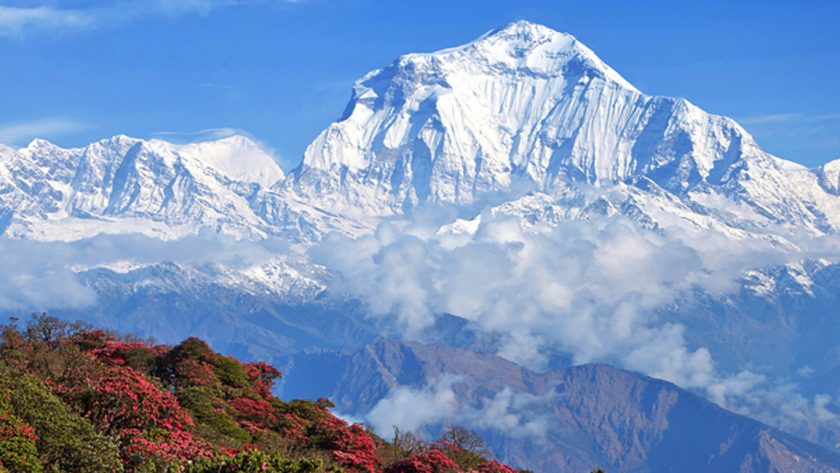Darshan never told me how old he was, but his manner gave him away as one who had seen too much despite his boyish features. His voice had a hardened texture, his gaze was resolute and without apology, and he lacked the affability for which Nepalis are legendary. He wore a blue sweater instead of military fatigues, and his demeanor implied he had been educated and was fairly refined.
We sat on the patio of a hiking lodge in a village on the way to Tatopani, sipping traditional black Nepali tea. The Annapurna range loomed all around us, full of majesty, and the voices of trekkers in countless languages passed through the village. Graffiti on the wall of the ramshackle lodge declared, “Down with American Imperialism.”
“Nepali government very bad,” Darshan explained. He spoke in a steady voice, and even the way he drank tea was controlled and deliberate. Six of his aides stood motionless, flanking him. “Government army very bad,” he said. “We want to fight, we want freedom, we want success for the Maoist duty.”
Darshan was a Maoist, a local commander in an army of between 15,000 and 50,000 guerrillas who follow a dogmatic version of Mao Zedong’s communist theory, who have been trying to overthrow Nepal’s constitutional monarchy in this nation of 25 million. The ensuing civil war has left as many as 10,000 dead (but no tourists), many of them killed by government soldiers as well as by Darshan’s compatriots. Some estimate that the Maoists control two-thirds of the countryside, but there is little doubt that the conflict is crippling the Nepali economy, especially tourism, with no end in sight.
The Maoists are also publicly, vehemently anti-American, as a result of aid the Bush administration has given to the Nepali government. For that reason, I drew upon my memory of a year spent in London to fake a mediocre British accent, which Raju, my porter turned impromptu translator, rendered in Nepali. Still, even with his minimal English, I was careful that Darshan not place me as an American – or, worse, a spy. After all, I was just a tourist.
Role Playing
Tourism is supposed to generate easy income for a host country. There are certain expectations: Tourists will not only spend money in restaurants, hotels, and with tour operators, but also wander the land, enjoying the scenery, taking voluminous amounts of photographs, expressing polite wonderment at the sights and occasional befuddlement at local customs. For the most part, tourists act as third-party observers to the culture swirling around them. This is only fitting in a country like Nepal, whose rigid caste system imposes strict rules of behavior and decorum.
The political instability in Nepal, where tourism is generates 17.1 percent of the GDP, has upset this delicate equilibrium. In late October, the U.S. State Department issued a travel warning for Nepal, quoting the Maoists’ supreme commander, Prachanda, as threatening to use “more violent means” if peace talks with the government fail. Though tourism is up this year, merchants remain desperate for business, and there is almost nothing they won’t do to sell just a few dollars of goods. “Morning business” is one of the methods I witnessed early on: A shop owner explains to a tourist that it’s good luck to offer a fair price on the first sale of the day, then haggles the hapless browser into buying. This technique is used well into the afternoon.
It often feels like this is the result of some fundamental misunderstanding. The prevailing attitude among Nepalis is that travel is a pursuit only of the wealthy. The managers of my guest house in Kathmandu had never been out of the Kathmandu Valley, a distance of less than 60 miles. Visiting Nepal as tourist means you have a measure of wealth and are met with a certain amount of deference and respect. This, of course, depends on which caste you may be speaking with. Upper caste Hindu Brahmins and Chetris may be your lodge owners , and see less of a social difference with you. The farmer/servant Tharus, who have benefited most from Maoist land grabs and redistribution among the poor, or a mountain Sherpa, could be your porter and make you feel like royalty with their bowing and averted gazes. But whatever their social level, many Nepalis often tried to calculate my class background by asking rapid-fire questions like “What is your father’s job?,” “How much do you earn?,” and “What is your education?” No question is too intrusive. Over meals, I had the pleasure of trying to explain why, at the ripe old age of 24, I have no children. I exhausted all my best arguments, but the Nepalis just nodded their heads, clearly sorry for me. On the other hand, I could tell my answer was satisfactory if they smiled and continued the questioning, reassured about my place in the tourist caste – though still mystified by the rules of that caste. Nepalis seemed confounded by Western customs and dress (particularly our lack of modesty around conservative Hindus and Buddhists), and by the social interaction between men and women.
Ben Harper in the Himalaya
Occasionally, though, a tourist’s interactions with locals can transcend bare necessity – Where is the museum? How much does this cost? – into something resembling friendship. Consider my twelve-day trek to Mount Everest Base Camp in the Solukhumbu region, east of Kathmandu. I arrived by plane into Lukla airport and within a half hour had arranged a porter, Ang Serki, who spoke only broken English and whose main concern was hauling my pack for me on the trails.
We spent the early days shuffling from one village to the next, acclimatizing slowly and relaxing in the lodges in the evenings. The daily climbs became more difficult as we rose in altitude, and I relied heavily on Ang Serki to speak with lodge owners on my behalf and to make medical inquiries when my altitude-induced headache was getting the best of me. I grew accustomed to seeing my blue North Face backpack bobbing ahead of me on the trails, as he carried it ahead, dodging yaks and giving the occasional backward glance to make sure his client was still conscious.
We settled into an unspoken routine, and within a few days, all it took was a gentle shake of my Nalgene bottle for him to fill it from a nearby stream so I could treat it with iodine. When we did speak, I besieged him with questions about the Himalayas and Buddhism. His younger brother, a student at a Buddhist monastery, arranged for me to have a meeting in Tengboche with the head lama, who blessed me and placed a red string around my neck for good luck. I loaned Ang Serki my CD player on the trails and introduced him to the sounds of James Taylor, Jack Johnson, and Ben Harper. I remember my first shriek of excitement when I heard him singing along to James Taylor’s “Carolina on My Mind”. He removed the headphones, grinned, pointed out Ama Dablam, a famous Himalayan peak to the east, and returned to my music.
It was through Ang Serki that I began to decipher the Nepali way of speaking English, which is predicated on learning one verb and structuring all sentences around it. Ang Serki’s word was take. “Did you take the sleep last night?” “Will you take anything for lunch?” When we arrived at our destinations in the evenings, he would deposit my pack in my room and silently bow before returning to his own quarters to play cards with the other porters. On the trails, he and I grew fiercely competitive, refusing to let other trekkers overtake us. We would delight in breezing by backpackers, especially if their bags bore flag patches from the EU or Canada. We were bringing the glory back to American trekking, I reckoned. It was twelve days of nearly nonstop companionship, exactly the sort of cultural exchange I’d hoped for.
When we returned to Lukla, it was time for me to pay Ang Serki. Before we’d left, we’d agreed on a daily rate that was generous by local standards ($10/day), I treated him to meals along the way, bought him the occasional Coca-Cola (a luxury item in the Khumbu region), and in the end offered him a sizable tip (equivalent to three-days wages). At the exact moment I was about to say goodbye and thank him for being such a trustworthy companion, he launched into a heart-wrenching monologue about his economic state and his need for some of my trekking gear, itemizing the helpful things he had done for me that warranted the donation. He was specific. He wanted my camera or my boots. I had heard about these end-of-trek speeches, and I did my best to be impervious to his requests, but Ang Serki’s performance was Oscar-worthy. His normally calm voice rose to a nearly hysterical pitch, and in the end, I returned to Katmandu sans hiking boots, feeling just a little bit conned. I suppose that’s just the way the game is played, each of us acting out our roles in a system that neither of us has the power or the will to bring down.
Take Me to Your Leader
The Maoists, however, have both, and they are changing the tourist-local dynamic in unforeseen ways. Although official reports state that no tourist has been harmed, a hotel in Katmandu was bombed in August (no one was hurt), and it is nearly impossible for an outsider to be unaware of the situation. The war pervades all guidebooks, and over Everest whiskey and Star lager, tourists excitedly tell stories of encounters with the Maoists. The English-language newspapers run cover stories on the latest alleged terrorist act, the death toll, and the various attempts to broker a ceasefire.
The Maoists have control over a large part of the popular trekking area around Annapurna, west of Kathmandu, and trekkers should expect to be stopped at some point by machine-gun-toting Maoists requesting a “donation” of 1,000 rupees (about $15) to finance their struggle. In return, they provide you a printed receipt in case you get stopped elsewhere. The receipt looks official and bears the hammer and sickle along with portraits of Mao, Lenin, and Stalin. I never met anyone who refused to donate.
After a long day of trekking I was recovering in a lodge in Ghorapani. A group of rebels nonchalantly entered and went from tourist to tourist, without need for introduction, collecting money. The Dutch trekkers near the door were first, calmly setting down their tea and opening through their wallets. Despite their hatred of American foreign policy, the Maoists specifically request American greenback “donations”.
When they came to me I had my porter, Raju, ask them for an interview with the local leader, offering to contact newspapers to carry the story. They considered my request, and decided to escort me to the next village to run this by their commanding officer, Darshan. (Finally, I had the satisfaction to use the line “Take me to your leader.”) As we left, I could see the lodge owner was clearly shocked I’d gotten involved.
Darshan, too, was surprised at my request, but he saw it as an opportunity to further the Maoist cause and dispel some misconceptions. At my insistence, we conducted the interview on the patio of a busy lodge, with trekkers passing by every few minutes.
Over the next several hours, Darshan told me about the Maoist party and his involvement with it. Three years ago, he and his fellow rebels had contacted the Nepal National Independent, a student union that supports the Maoists, who put him in control of the nearby villages.
The lack of modern transportation or communication meant that news and directives often took days to come from headquarters, and he possessed authority to make minor decisions.
I didn’t feel in any real danger, but remained cautious throughout the conversation. I was careful not to reveal any anxiety and kept my questions in an even tone. I took rough notes and attempted to lighten the mood by offering him some of my rations of crackers and Altoids, both of which he declined.
Their primary effort, Darshan stated, is to bring about is change the government rule. He said having the Maoists come to power would not necessarily eliminate the Nepali monarchy. But it’s important to make people equal – a true democracy, which, he explained, required eradication of the caste system. Darshan cited “big and small players” in the system of five distinct classes.
Maoists claim to want to help the lowest castes. They cite Mao Zedong’s campaign “Let a 1000 Flowers Bloom” in1950s China as the successful model for the communist revolution because, in Darshan’s words, “they want to use Mao’s lessons of helping people and giving freedom.” Their mission is to educate and to make everybody equal, both financially and socially. They did not seem particularly concerned with the way Mao and his policies have been treated by history.
The Maoists’ system favors a redistribution of wealth from rich to poor, with the incentive being that everyone will be “working for duty, working for others.” In essence, Darshan claimed, the Maoists want to counter the inherently selfish nature of humans.
As he spoke, the six men behind Darshan remained quiet, occasionally looking at one another and nodding in silent agreement.
I brought the conversation around to the charges against the Maoist party, such as the acts of terrorism they are reputed to have carried out, allegations that they recruit children, and their practice of accosting trekkers for funds. Darshan toed his party line, spinning that the so-called terrorism is simply reactionary to government acts, and the recruitment of children is a “youth movement.”
At the end of the interview, I declined an offer from Darshan to take me to the High Commander, who was a 15-days’-walk away. He also let me know that it was the first time he had conversed at length with any tourist.
Freedom to Discover
In third world countries, political issues may be played out at a grass-roots, organic level, and the impulse to get involved may be strong for a modern traveler. But what are a travelers’ responsibilities? I can’t imagine many tourists wanting to storm the United States Congress in Washington, D.C., or the Diet in Berlin, but the policies of these institutions are somewhat removed from visibility for the recreational traveler.
Western governments subscribe “constructive engagement”; trade involvement with developing nations can have a positive effect, socially and politically. On a smaller scale, individual tourism is a similar choice. Some believe that the presence of westerners with democratic ideals has a constructive impact on the country visited. It is interesting to wonder if countries rife with human rights violations are tempered by the existence of visitors to their tourist areas. Inversely, travelers can choose to boycott areas whose core values do not agree with their own. In fact, in 2003, EthicalTraveler.com proposed a fairly effective, somewhat controversial, high-publicity five-week travel boycott of Nepal for their policy of returning Tibetan refuges to the Chinese government.
Perhaps we are drawn to travel, and specifically to places with a wide cultural divide, in order to bear witness. Events that evoke discomfort, pity, wonder, wistfulness – intense emotions- solidify our own worldview. Prayer flags at 20,000 feet, a caste-bound farmer struggling in a field, a Buddhist monk and an AK47-toting rebel passing each other on the trails – these extremes far from the complacent normalcy of home challenge and change our own value system. We have our own traveler’s caste, (complete with mandatory GoreTex and fleece dress codes, shrines to our digital cameras, and judgments on the value of cultures around us), that we must break free from.
Nepal is the home of Mt. Everest, countless ancient pagodas and magnificent natural beauty. It is an adventurer’s playground and a photographer’s dream. It’s also struggling with massive cultural and political change. Among it all are thousands of trails, and discovery awaits no matter which path you take. Just don’t forget to bring a second pair of hiking boots.



